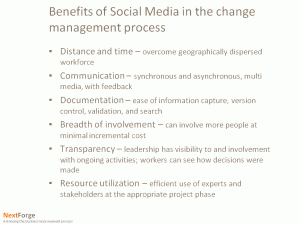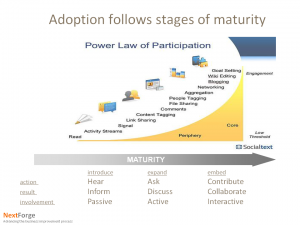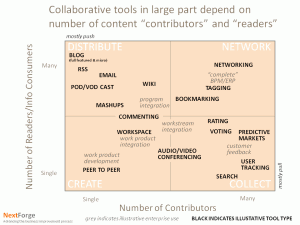RISING IMPORTANCE OF SOCIAL MEDIA
The pressures on today’s organization have been well documented; simply stated, the pace of change has begun to outstrip the enterprise’s capacity and capability to change.
- Some 83% of CEOs expect to face the need for substantial change, not “single-axis” change, but complex change. These same CEOs report that fewer than half of projects are completed successfully. [IBM]
- The always-on, multitasking expectations of individuals have become so distracting they sap productivity. [McKinsey]
- The human brain appears to be “wired” for communities of only 150 people, sometimes called the Dunbar number, a small fraction of the typical Fortune 500 workforce and customer/supplier base. [WSJ]
 It is no longer a question of “if” but of “when” an enterprise will adopt social media in order to overcome these and other challenges. Two-thirds of respondents to a recent McKinsey survey acknowledge using Web 2.0 tools in the organization today with 9 of 10 reporting at least one measurable benefit. Other documented examples include: increased revenues from new products, faster time-to-market, and staff productivity gains through access to expertise regardless of location.
It is no longer a question of “if” but of “when” an enterprise will adopt social media in order to overcome these and other challenges. Two-thirds of respondents to a recent McKinsey survey acknowledge using Web 2.0 tools in the organization today with 9 of 10 reporting at least one measurable benefit. Other documented examples include: increased revenues from new products, faster time-to-market, and staff productivity gains through access to expertise regardless of location.
However, the internal stresses on an organization create a false barrier to adoption of new, technology-enhanced behaviors of collaboration: existing operational demands, remediation and work-arounds, and the new workload of change programs.
- Time/resource compression to conduct business
- Limited cross-organizational sharing
- Broken processes
- Cycle of recurring performance breakdowns
- Comprehensive set of change initiatives
 New tools, technologies, and approaches can be applied to proven change management and behavioral change principles to reduce both the stress and risks of implementation. Projects can now deliver on two fronts: delivery of defined project elements and the development of the organization’s ability to change.
New tools, technologies, and approaches can be applied to proven change management and behavioral change principles to reduce both the stress and risks of implementation. Projects can now deliver on two fronts: delivery of defined project elements and the development of the organization’s ability to change.
Established and emerging social media can overcome some of the success barriers encountered with the traditional approach to change, in particular: communication, collaboration, buy-in, and adoption.
CHANGE MUST (STILL) DRIVE BUSINESS RESULTS
We believe the application of social media to the change process should be focused on business outcome. First, in terms of defined project objectives, the effort should support an established business priority and demonstrate the value of a new approach, versus “selling” the new features of a technology. Second, in terms of building internal change capabilities, the effort should build a more collaborative community in terms of group interaction, participation, relationship building, and information sharing.
Changing behavior of the individual is central to changing behaviors of the organization. We believe the combination of individual skills, knowledge and abilities are the improvement building block for creating improvement acumen. Individuals with targeted improvement acumen understand the business context and demonstrate a bias-for-action to achieve results.
It is not easy. It is not fast. Adoption of collaborative behaviors based in performance acumen requires an environment to provide guidance, routines and interactions all supported by a technology enabled network.
- Guidance directs individual work to achieve operational improvement through strategic and operational plans, guiding principles, policies, expectations and communication. Focus on business results.
- Routines define support processes: decision making and community management, shared practices, techniques and tools, and measures. Refine supporting processes and build collective tool kits.
- Interactions form and access relationships and networks, and create paths to more sources of information. Access knowledge and patterns.
Typically these elements require change to the way we lead, as well as the way we execute at the individual, group and organization (iGO) level. Resources are always required to execute and we believe the foundation for successful individual is the networked organization.
ADOPTION REQUIRES BUSINESS RELEVANCE
 We recommend an approach designed for individual development in that adoption of new behaviors occurs in a series of steps, or waves. Much as in a marketing program, individuals must be encouraged to multiple trials before they become users, heavy users, and ultimately loyal followers. Social media can be introduced in three waves by using it to communicate, stimulate discussion, and ultimately foster collaboration.
We recommend an approach designed for individual development in that adoption of new behaviors occurs in a series of steps, or waves. Much as in a marketing program, individuals must be encouraged to multiple trials before they become users, heavy users, and ultimately loyal followers. Social media can be introduced in three waves by using it to communicate, stimulate discussion, and ultimately foster collaboration.
There has been a great deal of work done in this area of adoption, and how/when/why specific tools should be introduced. [see SocialText footnote]
IT’S (ALSO) ABOUT TECHNOLOGY
 A number of light-weight collaborative tools have become available. Fueled by the trend toward open source and open communication, simple, easy-to setup and use tools are changing how we interact socially and at work. These collaborative tools are providing a catalyst, and enabling, more “talent reach” within and across companies, both synchronously and asynchronously. Said another way, the tools enable more porous boundaries within our enterprise and supply chain. Additionally, these tools provide easier access to, development of, and use of, necessary information.
A number of light-weight collaborative tools have become available. Fueled by the trend toward open source and open communication, simple, easy-to setup and use tools are changing how we interact socially and at work. These collaborative tools are providing a catalyst, and enabling, more “talent reach” within and across companies, both synchronously and asynchronously. Said another way, the tools enable more porous boundaries within our enterprise and supply chain. Additionally, these tools provide easier access to, development of, and use of, necessary information.
We are placing a moniker of “collaborative tools” around this group of existing and emerging tools based on their value to how companies work; published articles may refer to these tools as web 2.0 (consumer) or enterprise 2.0 (corporate). By example, SharePoint is a platform that includes many of these tools, with more recent releases having an expanded reach.
We believe there are opportunities right now to increase project and process performance. And, in the near-term, for example, as the boomers retire, we believe there is an opportunity for organizations to capture their learning, to codify the information they may take with them without proactive interventions. Furthering the example, there could be very simple structures to reach out to retirees as a directed community, at their convenience and interest to contribute to issues and questions of those currently manning the guns.
GETTING STARTED (“So, how do you do this?”)
Introducing Social Media capabilities into the enterprise change process requires consideration of a number of essential workplan elements, including:
- Objectives – clearly define business outcomes and what is required within the organization to achieve these results, including individual skills, working environment, and enabling technology.
- Readiness Assessment – understand the work done to date and the organization’s self-perception prior to engaging a larger population; identification and segmentation of stakeholder groups; test for leadership commitment to change.
- Training & Promotion – follow a disciplined promotional approach (e.g. marketing funnel); develop program around business solutions; accommodate multiple learning styles and progression; integrate real-time project activities to leverage peer-to-peer knowledge transfer.
- Communication Planning & Execution – introduce new communication methods, expectations, and behaviors in addition to a fully developed traditional communication plan; leadership role models new, desired open behaviors.
- Community Management – build a discipline and capability to support diverse communities in different stages of development; includes alignment of objectives, foster development of new relationships and information pathways, build new processes to institutionalize emerging practices, encourage participation and trial, and monitor/guide community activity.
- Collaboration Tools – introduce relevant technologies to support content development, increased network development and participation, and information sharing; manage and resolve technology issues.
Appendix: 6 Ways to Get Business Value from Social Software (SocialText, excerpt)
Enterprise 2.0 deployments across an organization have failed 70 percent of the time because vendors and service firms tried to muscle users onto the system rather than present people with an easy, universal use case that yielded employees and the company immediate business value. That’s because many pieces of social software, while easy to use, require a fair amount of content creation. Consequently, at the early stages of an enterprise-wide adoption of social software, we see the power law of participation play a prevalent role, much like the consumer Web.
This law states that a minority of people contribute the majority of the content. Initially, most people are passive readers of that content. For example, on Wikipedia, 500, or .05 percent of users, account for 50 percent of the contributions to the online encyclopedia, while the vast majority of Wikipedia users don’t make a single contribution. With social software in an enterprise, the same holds true; a small minority of people will perform active roles such as editing a page, writing a comment or penning an internal blog post for their colleagues to read. As social software platforms have evolved, new capabilities such as micro-blogging have a lower threshold for participating.
To turn more people into contributors who can share valuable information with colleagues, companies should take small steps that help their users get acclimated to the system. More important, those first steps should provide the users with immediate and clear business value, which would prompt them to use the social tools more deeply.


